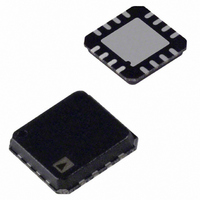AD8295ACPZ-RL Analog Devices Inc, AD8295ACPZ-RL Datasheet - Page 24

AD8295ACPZ-RL
Manufacturer Part Number
AD8295ACPZ-RL
Description
Dual Precision InAmp
Manufacturer
Analog Devices Inc
Datasheet
1.AD8295ACPZ-R7.pdf
(28 pages)
Specifications of AD8295ACPZ-RL
Amplifier Type
Instrumentation
Number Of Circuits
3
Slew Rate
2 V/µs
Gain Bandwidth Product
1MHz
-3db Bandwidth
1.2MHz
Current - Input Bias
500pA
Voltage - Input Offset
120µV
Current - Supply
2mA
Current - Output / Channel
18mA
Voltage - Supply, Single/dual (±)
4.6 V ~ 36 V, ±2.3 V ~ 18 V
Operating Temperature
-40°C ~ 85°C
Mounting Type
Surface Mount
Package / Case
16-LFCSP
Lead Free Status / RoHS Status
Lead free / RoHS Compliant
Output Type
-
Lead Free Status / RoHS Status
Lead free / RoHS Compliant
AD8295
TWO-POLE SALLEN-KEY FILTER
Figure 69 shows the in-amp output section of the AD8295 being
low-pass filtered using a two-pole Sallen-Key filter. The filter
section consists of Op Amp A2, External Resistors R1 and R2,
as well as Capacitors C1 and C2. Resistor R3 compensates for
input offset current errors and is equal to the parallel combination
of R1 and R2. The ratio of capacitance between C1 and C2 sets
the filter quality factor, Q. For most applications, a filter Q of 0.5
to 0.7 provides a good trade-off between performance and sta-
bility. High Q, nonpolarized capacitors, such as NPO ceramic,
should be used. The exact pole frequencies are dependent on
the tolerance of the resistors and capacitors used.
The design equations for a Sallen-Key filter can be greatly
simplified if the resistors and capacitors are made equal.
When C1 = C2 and R1 = R2, Q is 0.5 and the design equation
simplifies to
where R is in ohms and C is in farads.
For example, with R1 = R2 = 10 kΩ, and C1 = C2 = 2.2 nF,
When C1 is not equal to C2 and R1 is not equal to R2, the
values of Q and the cutoff frequency are calculated as follows:
–INPUT
+INPUT
f = 1/(2πRC)
f = 7.2 kHz
Q =
f
=
–IN
+IN
R
R
2
G
G
C2
π
R1
1
2
3
4
+V
–V
(
R1
16
R1
R2
5
AD8295
S
S
+V
–V
0.1µF
0.1µF
R2
Figure 69. Two-Pole Sallen-Key Filter
+
1
C1
S
S
R2
C1
C2
IA
)
C2
15
6
R1
REF
OUT
R2
A1
14
7
C2
A1
OUT
A2
+IN
A2
R1
20kΩ
R2
20kΩ
13
8
A1
R2
A2
–IN
C1
12
11
10
9
R3
A2
OUT
A1
+IN
A1
R1
A1
–IN
LOW-PASS
FILTERED
OUTPUT
Rev. A | Page 24 of 28
AC-COUPLED INSTRUMENTATION AMPLIFIER
The circuit in Figure 70 provides a single-pole high-pass filter,
using only one external capacitor.
At low frequencies, Capacitor C1 has a high impedance, thus
operating Op Amp A1 at high gain (G = X
its high gain, Op Amp A1 is able to drive the in-amp reference
pin until it forces the output of the in-amp to 0 V. Therefore, no
signal appears at the circuit output.
At higher frequencies, the gain of Op Amp A1 drops and the
op amp is no longer able to maintain the in-amp output at 0 V.
Therefore, at frequencies above the RC filter bandwidth, the
in-amp operates in a normal manner, and the signal appears at
the output.
The 3 dB corner frequency is set by Internal Resistor R1 and
External Capacitor C1 as follows:
The precision of R1 (better than 0.2%) means that the filter
bandwidth depends mainly on the tolerance of Capacitor C1.
At low frequencies, Op Amp A1 drives the appropriate voltage
on the reference pin to null out the original signal. Voltage
supplies should be chosen so that Op Amp A1 has enough
output headroom to produce the nulling voltage.
+INPUT
–INPUT
f = 1/((2π × 20 kΩ) × C1)
–IN
+IN
R
R
G
G
1
2
3
4
+V
16
AD8295
–V
S
5
S
Figure 70. AC-Coupled Connection
OUT
REF
IA
15
6
A1 OUT
A1
14
7
A2 +IN
A2
A1 R2
R1
20kΩ
R2
20kΩ
13
8
A2 –IN
12
11
10
C
9
/20 kΩ). Because of
C1
A2 OUT
A1 +IN
A1 R1
A1 –IN
OUTPUT











